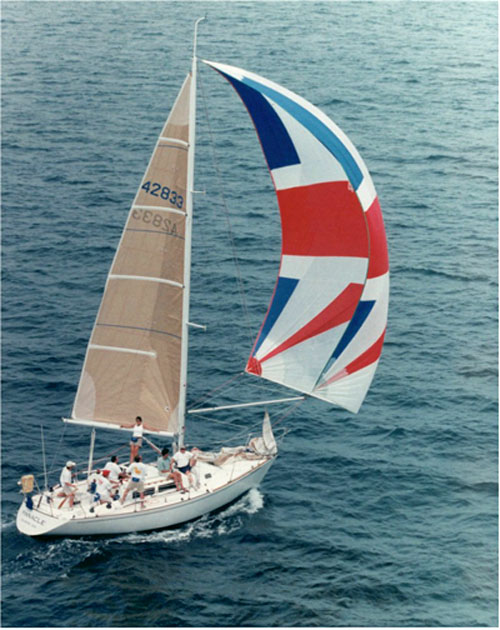OK it’s quiz time. Is the Frers 33 a racer/cruiser or is it a cruiser/racer? Congratulations, you’re right!

Limited production "race" boats may be the only things that become obsolete faster than computer hardware, so there are very practical marketing reasons for these dual purpose designs.
Designed by German Frers to optimize the new International Measurement System (IMS) rating rule, the Frers 33 was built from 1986 to 1992 and marketed by its builder, Carroll Marine Ltd. of Bristol, RI, as a racer/cruiser. What you choose to call this boat may be more a function of how you choose to use it than any other criteria. If you plan to race more than cruise, then you have a racer/cruiser and vice versa.
There is a fine and constantly changing line between these designations, and there are no hard and fast rules or numbers that define a racer/cruiser or a cruiser/racer. A review of two numbers commonly used to evaluate potential sailboat performance, the displacement to length (D/L) ratio and the sail area to displacement (SA/Disp.) ratio, show a rather broad range for a number of IMS-influenced "racer/cruisers" built in the ten years between 1986 and 1996. D/L ratios generally fell between 150 and 220 and SA/Disp. ratios in the range of 19.5 to 23. Since the intent of any dual-purpose design is to blend the design elements necessary for performance of a racing yacht with those design elements necessary for a successful cruising yacht, it makes sense that boats with numbers towards the performance extremes of these ranges could be aptly labeled racer/cruiser while those towards the cruising extremes could be cruisers/racers - but the choice is yours.
The principle dimensions of the Frers 33 are LOA 33’3"; beam 11’ 3"; displacement 9,000 lbs. and draft of 6’3". Literature indicates a shoal draft version was offered in 1991 and 92, drawing 4’11", although I have yet to see one.
To my eye, German Frers designs nearly always show ideal proportions for contemporary yacht design and the 33 is no exception. The sheerline is strong enough that it does not appear flat or hogged as the boat heels. In profile view, it may appear as if the freeboard is a little low and the cabin trunk a little high; however, when under sail I think the appearance will be just about right. The rake of the bow and stern are nicely balanced, and the look of the Frers trademark transom is very handsome.
In order to maximize strength and rigidity while, at the same time, keeping weight to a minimum, the hull and deck of the Frers 33 were built utilizing a composite construction of fiberglass and resin laminates on either side of a core material. The hull is cored with balsa throughout. Because balsa is subject to failure under high compression loads, deck areas subject to high compression loads are cored with plywood, and other deck areas are cored with balsa for its lighter weight.
When core material is introduced into a fiberglass composite, production quality control becomes considerably more important. Carroll Marine Ltd. has considerable experience building boats utilizing core materials and, for the most part, seems to do an outstanding job. My experience with the Frers 33 has shown no problems with the hull composites, although I have noted some failures of the athwart ship floor between the head and the hanging locker and some secondary bonding failures at the main structure bulkhead port and starboard of the mast. My experience has shown mild to moderate delamination and moisture penetration of the decks which further emphasizes the absolute necessity for properly mounting deck hardware on any cored deck.
The accommodations aboard the Frers 33 certainly tend toward the cruiser side of racer/cruiser designs and are substantially more comfortable than IMS-influenced designs of the late 80s and early 90s. There is a V-berth forward that comfortably accommodates two adults followed by head and shower along the port side with hanging locker on the starboard. The main saloon offers an L-shaped settee along the port side and settee along the starboard. Some boats were fitted with optional pilot berths on each side of the main saloon. The galley with stove, sink, and top loading ice box is aft along the starboard side, and there is a double quarter berth and navigation station aft along the port side. Standard auxiliary power is a 2 cylinder, 18 Hp Yanmar diesel which is sufficient.
I must admit that, with the exception of an occasional sea trial, I have not had the opportunity to sail or race a Frers 33. However, the D/L ratio of 20.7, SA/Disp. ratio of 215 and a ballast to displacement 44% are all quite conservative. The typical hull distortions that were encouraged by the IOR rule and often led to bad handling characteristics, were not favored by the IMS rule and none are present in this design. This should be a very well-mannered design that shouldn’t produce any surprises in performance or handling. A narrow waterline beam may result in a little initial tenderness; however, with an overall beam of 11’ 3", draft of over 6’ and adequate ballast displacement ratio, she should stiffen up nicely at 15% of heel or so.
For the thin water preferred by some Chesapeake Bay area cruising sailors, the standard draft of 6’ 3" will be a bit of a concern. However, if you’re a cruiser/racer or racer/cruiser whatever you choose to call it, the Frers 33 remains an excellent choice to fill the bill more than a dozen years after its introduction
Reviewed by Jack Hornor in the September 1998 issue of SpinSheet




